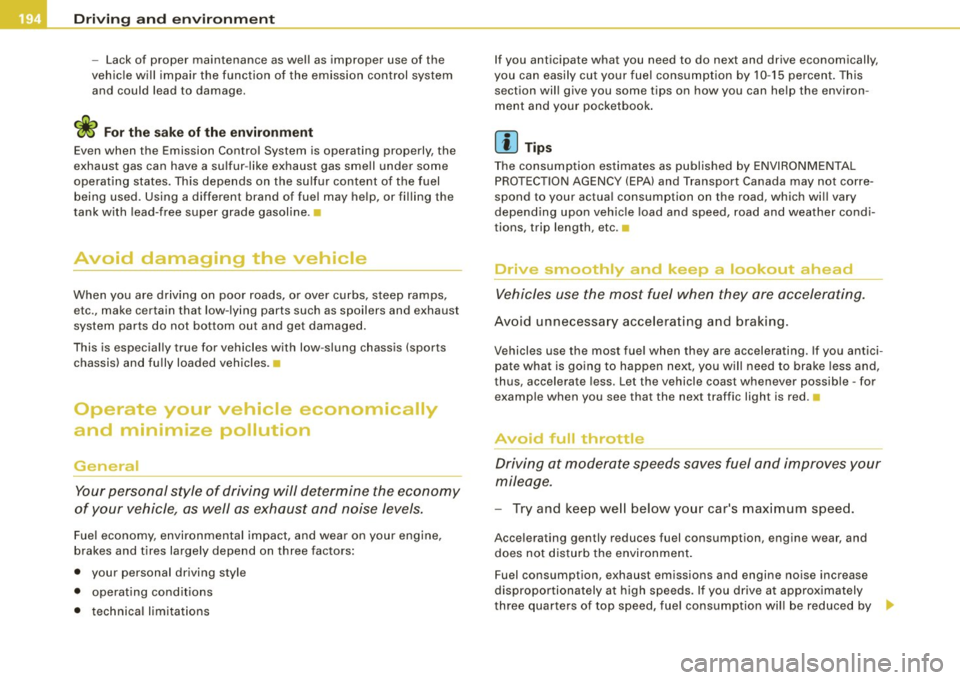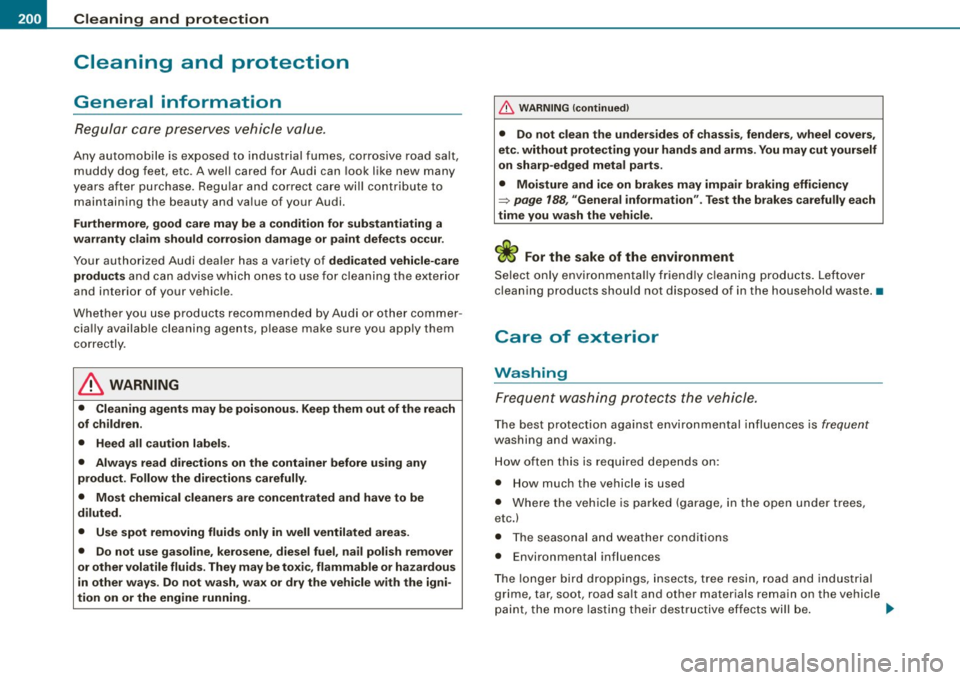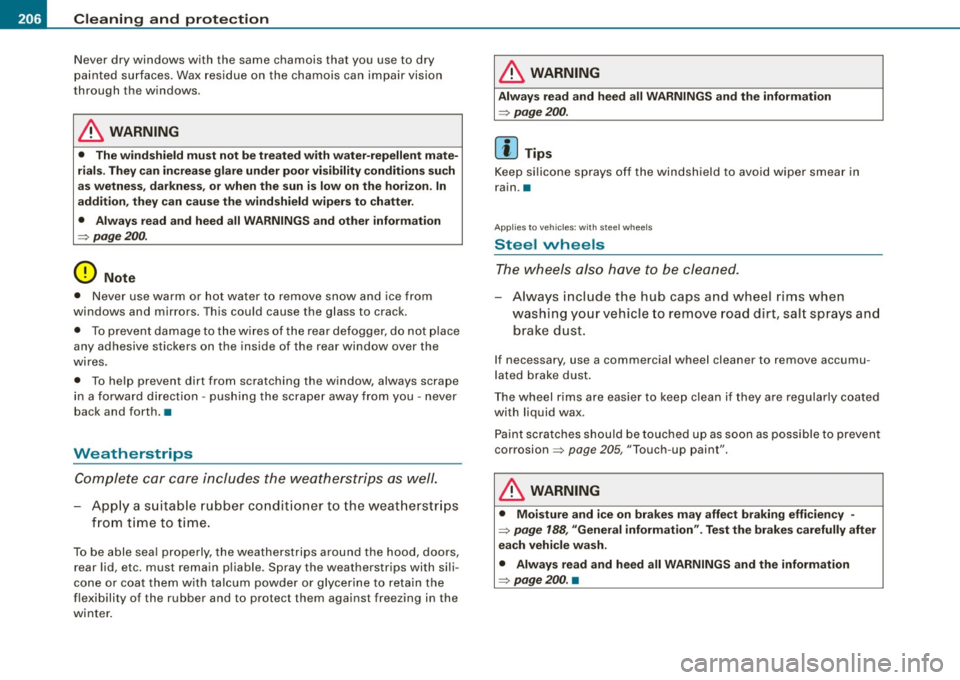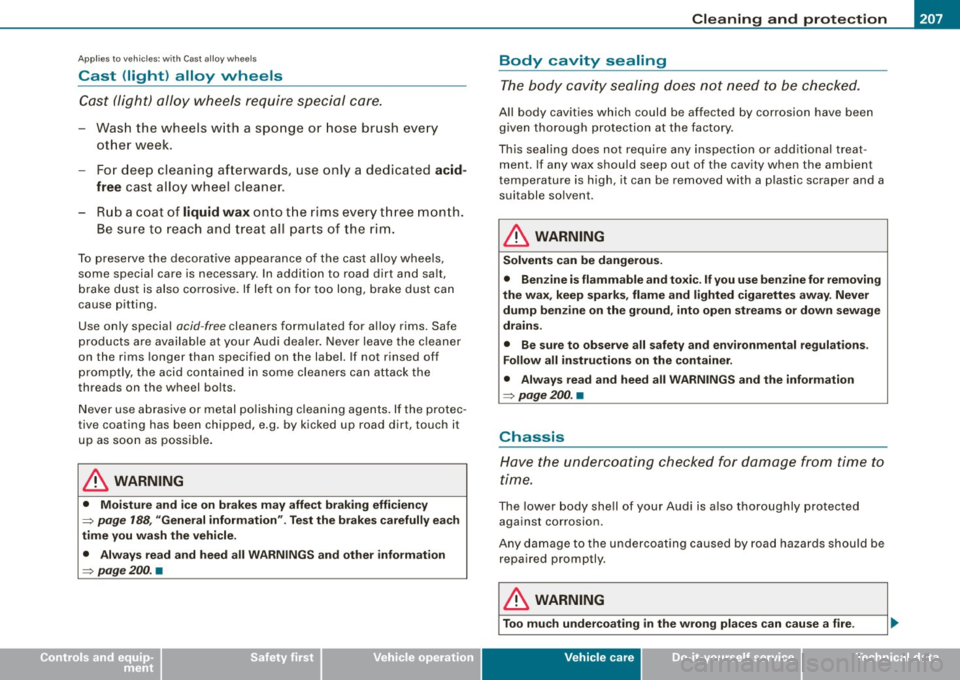2008 AUDI TT ROADSTER brake
[x] Cancel search: brakePage 196 of 316

___ D_ r_ iv _i_ n-' g"'""'- a_ n_d_ e_ n _ v_i_r _ o _n_ m_ e_ n_t _____________________________________________ _
- Lack of proper maintenance as well as improper use of the
vehicle will impair the function of the emission con trol system
and could lead to damage.
exhaust gas can have a su lfur -like exhaust gas smell under some
operating states . This depends on the su lfur content of the fuel
being used. Using a different brand of fuel may he lp, or filling the
tank with lead-free super grade gasoline. •
Avoid damaging the vehicle
When you are driving on poor roads, or over curbs, steep ramps,
etc., make certain that low-lying parts such as spoilers and exhaust
system parts do not bottom out and get damaged.
This is especially true for vehicles with low-slung chassis (sports
chassis) and fully loaded vehicles. •
Operate your vehicle economically
and minimize pollution
General
Your personal style of driving will determine the economy
of your vehicle, as well as exhaust and noise levels.
Fuel economy, environmental impact, and wear on your engine,
brakes and t ires largely depend on three factors:
• your personal driving style
• operating condit ions
• technical limitations If
you anticipate what you need to do next and drive economically,
you can easily cut your fuel consumption by 10-15 percent . This
section will give you some tips on how you can he lp the environ
ment and your pocketbook .
[ i ] Tips
The consumption estimates as published by ENVIRONMENTAL
PROTECTION AGENCY (EPA) and Transport Canada may not corre
spond to your actua l consumption on the road, which will vary
depend ing upon vehicle load and speed, road and weather condi
tions, trip length, etc. •
Drive smoothly and keep a lookout ahead
Vehicles use the most fuel when they are accelerating.
Avoid unnecessary accelerating and braking.
Vehicles use the most fue l when they are accelerating . If you antici
pate what is going to happen next, you will need to brake less and,
thus, accelerate less. Let the vehicle coast whenever possible -for
example when you see that the next traffic light is red. •
Avoid full throttle
Driving at moderate speeds saves fuel and improves your
mileage.
- Try and keep well below your car's maximum speed.
Acce lerating gently reduces fuel consumption, engine wear, and
does not disturb the environment.
Fuel consumption, exhaust emissions and engine noise increase
disproportionately at high speeds. If you drive at approximately
three quarters of top speed, fuel consumption wil l be reduced by
9J,,
Page 202 of 316

___ C _l_e _a _ n_ in_g ~_ a_n _ d ___ p ___ r_ o _t _e _c_ t_ i_o _ n _____________________________________________ _
Cleaning and protection
General information
Regular care preserves vehicle value.
Any automobile is exposed to industrial fumes, corrosive road salt,
muddy dog feet, etc . A wel l cared for Audi can look like new many
years after purchase. Regu lar and correct ca re will contribute to
maintaining the beauty and value of your Audi.
Furthermore, good care may be a conditi on for substantiating a
war ranty claim should co rros ion d amage or p aint defec ts occur .
Your authorized Audi dealer has a variety of dedi cated vehicle- care
product s
and can advise whic h ones to use for cleaning the exterior
and interior of your vehicle.
Whether you use p roducts recommended by Audi or other commer
cially availab le cleaning agents , please make sure you apply them
correctly.
& WARNING
• Cleaning agents may be poisonous . Keep them out of the reach
of ch ildren .
• Heed all caution label s.
• Alway s read directions on the contai ner before u sing any
produ ct. Follow the di rection s carefull y.
• Most chemical cleaner s are concentrated and have to be
d iluted .
• Use s pot removing fluids only in well ventilated area s.
• Do not us e gasoline , ker osene , die sel fuel , nail polish rem over
or oth er volatile fluid s. They may be toxi c, flammable or ha zardous
in other way s. Do n ot w ash, wa x or dry the vehicle w it h the igni
tion on or the engine running.
& WA RNIN G (conti nued)
• Do not clean the under side s of chassis , fe nder s, wheel cove rs,
etc . without protecting your hands and arm s. You may cut yourself
on sha rp -edg ed metal part s.
• Moisture and ice on brakes may impair braking eff iciency
=> page 188 , "General info rm ation ". Test the brake s carefully each
time you wa sh the vehicle.
~ For the sake of the environment
Se lect only environmenta lly friend ly c leaning products . Leftover
clean ing products should not disposed of in the household waste. •
Care of exterior
Washing
Frequent washing protects the vehicle.
Th e best protection against envi ronmental influences is frequent
washing and waxing .
H ow often t his is required depends on:
• H ow much the vehic le is used
• Where the vehicle is pa rked (garage, in the open under t rees,
etc.)
• The seasonal and weather conditions
• Environmental influences
T he longer bird droppings, insects, tree resin, road a nd industrial
grime, tar, soot, road salt and other materials remain on the vehicle
p aint, the more lasting their dest ructive effects will be . _,,,
Page 208 of 316

___ C_ le_ a _ n_i_n ~g _ a_ n_ d __ p_r _o _t _e _c_ t_ i_o _n ___________________________________________ _
Never dry windows with the same chamois that you use to dry
painted s urfaces. Wax residue on the chamois can impair vision
through the windows .
& WARNING
• The windshield must not be treated with water-rep ellent mate
r ial s. They can increa se glare under poor visibility conditions such
a s w etne ss, darkne ss, or when th e sun i s lo w on th e hori zon. In
addition , they can c ause the wind shield wipers to chatter .
• Alw ays re ad and heed all WARNINGS and oth er infor matio n
=>
pa ge 200.
0 Note
• Never use warm or hot wa ter to remove snow and ice from
windows and mirrors. This could cause the glass to crack.
• To prevent damage to t he w ires of the rear defogger, do not p lace
any adhesive stickers on the inside of the rear window over the
wires.
• To he lp prevent dirt from scratching the w indow, always scrape
in a forward direction - pushing the scraper away from you -never
back and forth .•
Weatherstrips
C omplete car care includes the weatherstrips as well.
- App ly a suitable rubber co nditioner to the weat herstr ips
f rom t ime to t ime .
To be able sea l properly, the weatherstrips around the hood, doors,
rear lid, etc. must remain pliable . Spray the weath erstrips with si li
cone or coat them w ith ta lcum powder or glycerine to retain the
flexibili ty of the rubber and to protect them against free zing in the
winter .
& WARNING
Always read and he ed all WARNINGS and the inf orm ation
=>
page 2 00 .
[ i ] Tips
Keep si licone sp rays o ff the windsh ield to avo id wiper smear in
rain .•
A pplies to vehi cles : w it h s tee l w hee ls
Steel wheels
The wheels also have to be cleaned.
Always include the hub caps and wheel rims when
washing your vehicle to remove road dirt, sal t sprays and
brake dust.
If necessary, use a commercial wheel cleaner to remove accumu
l ated brake dust.
The wheel rims are eas ier to keep clean i f they are regularly coated
wi th liquid wax .
Paint scratches should be touc hed u p as soon as possible to prevent
corrosion=>
page 205, " T ouch -up paint".
& WARNING
• Moisture and ice on brakes m ay affe ct br aking efficie ncy -
=>
page 188 , "Gene ral information ". Te st the brake s carefull y after
e ac h vehi cle wa sh .
• Alway s read and heed all WARNINGS and the information
=>
pa ge 200. •
Page 209 of 316

Cleaning and prote ction BIii
------------------------------------=-----=-------
•
Ap plies to vehi cles : w it h C ast a llo y wh eels
Cast (light) alloy wheels
Cast (light) alloy wheels require special care.
-Wash the wheels w ith a sponge or hose brush eve ry
ot her week .
- For de ep cleaning afterwar ds, use only a dedicated
acid
free cast alloy wheel cleaner .
- Ru b a c oat of
liquid wax on to t he rims every t hree mon th.
B e sure t o reach and treat all parts of the rim .
To preserve the decora tive appearance of the cas t alloy whee ls,
some special care is necessary . In addition to road dirt and sa lt ,
b rake dust is also co rro sive . If left o n fo r to o long, brake dust can
cause pitting .
Use only special
ac id -free cleaners formulated for alloy rims . Safe
products are available at your Audi dea ler . Never leave the cleaner
on the r ims longer than specified on the label. If not rins ed off
promp tly, the acid contained in some cleaners can a ttack the
threads on the wheel bolts .
Never use abrasive or me tal po lishing cleaning agents . If the protec
tive coat ing has been chipped, e .g . by kicked up road dirt. touch it
up as soon as possib le .
& WARNING
• Moi sture and ice on brakes may affect braking efficiency
=> page 188 , "General information ". Te st the b rake s c arefully ea ch
time you wash the vehicle.
• Alway s read a nd heed all WARNINGS and other informat ion
=> page 200 . •
Body cavity sealing
T he body c avity sealing d oes not need t o be checke d.
A ll body cavities which could be aff ected by corrosion hav e been
given thor ough protecti on a t the facto ry.
This sealing does not require any inspection or add itional treat
ment . If any wax shou ld seep out of the cavity when the ambient
tempera ture is high , it can be removed wi th a p las tic sc raper and a
suitable solvent.
& WARNING
Solvent s can be dangerous.
• Benz ine is flammable and to xic . If you use benz ine for removing
the wax , keep sparks , flame and lighted cigarettes away . Never
dump benz ine on the ground , into open streams or down sewage
drains .
• Be sure to observe all safety and environmental regulat ions .
Follow all instru ctions on the container.
• Always read and heed all WARNINGS and the information
=> page 200 . •
Chassis
Have the undercoa ting checked for damag e from time to
time .
The lowe r body shell of your Audi is a lso thoroughly protected
against corros ion.
Any damage to the undercoating caused by road ha za rds sh ould be
repaired promp tly .
& WARNING
Too much unde rcoat ing in the wrong pla ces can cause a fire .
Vehicle care
I t •
Page 222 of 316

-~_C_ h_e _c _ k_ i_n ...:::g::;...._ a_n_ d_ f_ i_ll _in -'g:::;.._ ___________________________________________ _
Closing the engine hood
- Pull the hood down until the pressure from the struts is
reduced.
- Let the hood
drop down and latch in place. Do not try to
push it shut;
it may fail to engage~& .
& WARNING
A hood that is not completely latched could fly up and block your
view while driving.
• When you close the engine hood, check it to make sure the
safety catch has properly engaged. The hood should be flush with
the surrounding vehicle body parts.
• If you notice while driving that the hood is not secured prop
erly, stop at once and close it. •
Working in the engine compartment
Be especially careful whenever you work in the engine
compartment!
Whenever you must perform any work in the engine compartment,
for example checking and filling the different fluids, there is a risk of injury, burns and accidents. To prevent personal injury always
observe the following WARNINGS. The engine compartment of any
vehicle is a hazardous area!
=> &
& WARNING
To help avoid injury, before you check anything under the hood :
• Switch off the engine.
• Remove the ignition key.
• Apply the parking brake.
& WARNING (continued)
• Move selector lever of automatic transmission to "P" {Park);
put manual transmission in Neutral.
• Always let the engine cool down. Hot components will burn
skin on contact.
• To reduce the risk of being burned, never open the hood if you
see or hear steam or coolant escaping from the engine compart
ment. Wait until no steam or coolant can be seen or heard before
carefully opening the hood .
• Keep children away from the engine compartment.
• Never spill fluids on hot engine components. They can cause a
fire.
• Never touch the radiator fan. The auxiliary electric fan is
temperature controlled and can switch on suddenly.
• Never open the coolant reservoir cap when the engine is still
warm. The coolant system is pressurized and hot coolant could
spray out.
• Protect your face, hands and arm from steam or hot engine
coolant by placing a thick rag over the cap when you open the
coolant reservoir.
• If work on the fuel system or the electrical system is necessary:
- Always disconnect the battery .
- Never smoke or work near heaters or open flames. Fluids in
the engine compartment could start a fire.
- Keep an approved fire extinguisher immediately available.
• To avoid electrical shock and personal injury while the engine
is running or being started, never touch :
- Ignition cables
- Other components of the high voltage electronic ignition
system.
• If you must perform a check or repair with the engine running: .,_
Page 223 of 316

_____________________________________________ C_h_ e;::..:. c:..:..k :..:..in ;..:..= g:.....:.; a:..:..n :....:d :..:....:. f.:.:il .:.:li :..:..n :.::g:!-_ ___,J-
& WA RNING !continued )
-First, fully apply the parking br ake , move selector lev er of
automatic tran smi ssion to "P " (P a rk ); put manu al tran smi ssio n
in Neutral.
- Alw ays use extreme c aution to p revent clothing, j ewelry , or
long hair from getting caught in the radi ator fan , V -belts or
other moving pa rt s, or from c onta cting hot parts. Tie b ack hair
before starting , and wear no cloth ing th at will hang or droop
into the engine.
• Minimize exposure to emi ssion and ch emical hazards
:=> & .
& WARNING
California Propo sition 65 Warning :
• Engine exha ust , some of its constituent s, and certa in vehi cle
c omponents contain or emit chemical s known to the State of Cali
fornia to cause cancer and birth defe cts and reprodu ctive harm . In
addition , certain fluid s cont ained in vehicle s and certain produ cts
of compone nt wear contain or emit chemi cals known to the State
of Cal ifornia to cause cancer and birth defe cts or oth er repr oduc
tive ha rm.
• Battery post s, terminals and related ac cess ori es conta in lead
and le ad compou nds , c hemic als kno wn to th e St ate of California
to c ause cancer and reproductive harm s. Wa sh hand s after
ha ndling.
0 Note
When adding fluids , always make sure that they are poured into the
proper container o r filler opening, otherwise ser ious damage to
vehicle systems will occur .
ffi For the sake of the environment
To detect leaks in time, inspect the vehic le floor pan from under
neath regularly. If you see spots from oil or other vehicle fluids, have
your vehicle inspected by an authorized Aud i dealer .•
Engine compartment
Ap plies to vehic le s: wit h 1.8 I1 80-h p engi ne
2.01 200 -hp engine
These ar e the most im por tant i tems tha t yo u can check.
Fig . 149 En gine c omp art men t: 2.01 200 -hp engine
0 Coolan t expansion tank (J_ ) ..... .... ........ ..• ..
0 Engine oil filler cap(~) ... ... .. .. .... .... ... ... .
© Engine oil dipstick (orange) ........ ....... ..... . .
© Brake fluid reservoir ( ) . .... .. ... .. ...... ... ... .
Vehic le care I I
228
225
224
230 .,.
irechnical data
Page 224 of 316

-Checking and filling P'll:I ---=---------------
© Jump start points(+) under a cover, ( -) bolt head
© Windshield/headlight washer container ( O ) .. ... .. .
& WARNING
Before you check anything in the engine compartment, always
read and heed all WARNINGS
~ & in "Wo rking in the engine
compartment" on page
220. •
Applies to v ehi cles: with 3,2 1 250 -h p eng in e
3 .21 250 -hp engine
279
236
These are the most important it ems that you can check.
Fig . 150 Engine compartment: 3.21 250-hp engine
G) Coolant expansion tank (J -) ..... ... .. ..... .. ... .
0 Engine oil dipstick (orange) . ... .. ...... ........ . .
© Engine oil filler cap (
228
224
225
230
© Jump start points(+) under a cover,( -) bo lt head ... .
© Windshield/headlight washer container (O ) .. .... . .
& WARNING
Before you check anything in the engine compartment, always
read and heed all WARNINGS
~ & in "Working in the engine
compartment" on page
220. •
Engine oil
Engine oil specifications
279
236
The engine oil used in your Audi needs the right kind of
oil.
The engine in your Audi is a sophisticated powerp lant that was built
to exacting specifications. This engine needs the right kind of
engine oil that meets specifications regarding quality and viscosity
so that it can run smoo thly and re liably. Choosing the right oil and
changing oil wi thin the time and mileage interva ls printed in your
vehic le's Maintenance
& Warranty booklet matters a lot more today
than it did years ago. Audi has developed a special quality standard
for engine oil that will help assure that your vehicle's engine will get
the lubrica tion it needs for proper operation.
Modern engine lubrication has taken a quantum leap in the last few
years. Many synthetic oils available today provide better engine
lubrication that can outlast traditional petroleum -based oils,
making them a smart choice for use throughout the life of your Audi.
Whether you use synthe tic or petro leum-based engine oil, the oil
that you use must conform to Audi's oil quality standard VW 502 00
to help keep your vehicle's engine running smoothly and help prevent the formation of harmful deposits, sometimes called
"sludge,' ' that over time can lead to expensive repairs. •
Page 232 of 316

___ C_h_ e_ c_k _in --== g'-- a_n _d_ f_il _li _n ..:::g:::..- ___________________________________________ _
& WARNING (continued)
• The auxiliary electric fan is temperature controlled and can
switch on suddenly even when the engine is not running.
• The auxiliary radiator fan switches on automatically when the
engine coolant reaches a certain temperature and will continue to
run until the coolant temperature drops. •
Brake fluid
Checking brake fluid level
The brake fluid level can be checked with a quick glance.
Fig. 155 Engine
compartment: brake
fluid reservoir
Before you check anything in the engine compartment,
always read and heed all WARNINGS =>
& in "Working in
the engine compartment" on
page 220.
- Read the brake fluid level from the brake fluid reservoir
~ fig. 155. The brake fluid level must be between the
"MIN" and "MAX" markings.
The brake fluid reservoir is located behind the rear partition of the
engine compartment on the left side~
page 221 .
The fluid level may drop slightly after some time due to the auto
matic adjustment of the brake pads. This is not cause for alarm.
If the brake fluid level falls
considerably below the "MIN" mark, the
brake warning/indicator light (U .S. models:
BRAKE , Canadian models:
ill) will come on~ page 20 and~ page 32. Do not continue to
operate the vehicle . The complete brake system should be thor
oughly checked by an authorized Audi dealer or other qualified
facility and the cause corrected. If the brake fluid level is too low, the
brake warning/indicator light will illuminate. Contact an authorized
Audi dealer
immediately .•
Changing brake fluid
Have the brake fluid changed by an experienced techni
cian.
Brake fluid absorbs moisture from the air. If the water content in the
brake fluid is too high, corrosion in the brake system may result
after a period of time. The boiling point of the brake fluid will als o
decrease considerably and decrease braking performance.
Therefore, the brake fluid must be changed
every two years. Always
use new brake fluid which conforms to Federal Motor Vehicle Stan
dard "FMVSS 116 DOT 4".
The brake fluid reservoir can be difficult to reach, therefore, we
recommend that you have the brake fluid changed by your autho
rized
Audi dealer . Your dealer has the correct tools, the right brake
fluid and the know -how to do this for you.
& WARNING
• Brake fluid is poisonous. It must be stored only in the closed
original container out of the reach of children!
• Brake failure can result from old or inappropriate brake fluid.
Observe these precautions : .,,_